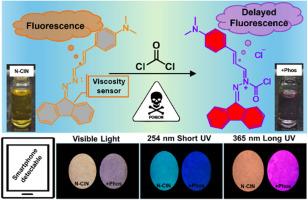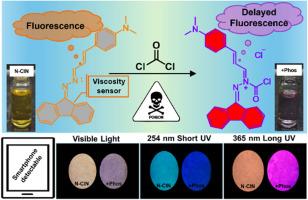用红发射探针在溶液和气相中快速检测光气:延迟荧光的出现
IF 6
2区 化学
Q1 CHEMISTRY, ANALYTICAL
引用次数: 0
摘要
背景光气是一种剧毒、易挥发、臭名昭著的气体,由于意想不到的恐怖袭击和工业灾难可能对公共安全和人类造成重大威胁,需要迅速关注。尽管基于不同概念的多种光气检测方法已经发表,但它们仍然受到低流动性、高成本和复杂过程的阻碍。因此,快速、方便、准确地检测光气是当前时代的需要。因此,需要易于管理、具有快速响应时间并具有实时监控潜力的用户友好的替代方案。本研究旨在开发一种高选择性和敏感的比色和荧光探针,该探针可以在开启荧光模式下检测光气,强度增加15倍,可见颜色从黄色变为蓝色,无需专门的笨重设备即可进行视觉识别。此外,探针本身对pH值和粘度有明显的响应。在其他干扰物质存在的情况下,探针对光气表现出高水平的选择性。最终形成的光气化合物表现出热激活延迟荧光的新性质,其寿命为7.78 μs。这种反应是由于酰基化过程导致新产物的形成,通过各种分析工具(如HPLC, IR, Mass和其他分析工具)进行了研究。该探头反应时间不到5秒,检测限为17.7 ppb。它能够检测各种土壤样品中光气的存在。制作了一种简单方便的基于智能手机的纸质测试试剂盒,它在不同的通道中给出了不同的颜色,显示了在任何可能的通道中感知光气的优越能力。本文章由计算机程序翻译,如有差异,请以英文原文为准。


Rapid phosgene detection with red emissive probe in solution and Vapor Phase: Emergence of delayed fluorescence
Background
Phosgene is a highly toxic, volatile, and notorious gas that needs quick attention due to its significant threats to public safety and humanity that could arise from unexpected terrorist attacks and industrial disasters. Although multiple approaches based on diverse concepts have been published for phosgene detection, they are still hampered by low mobility, high cost, and complex processes. Hence, quick, convenient, and accurate detection of phosgene is a current need of the time. Therefore, user-friendly alternatives that are easy to manage, have quick response times, and bear the potential for real-time monitoring were required.
Results
This study aims to present the development of a highly selective and sensitive colorimetric and fluorometric probe that can detect phosgene in a turn-on fluorescence mode, having a 15-fold increase in intensity, with a visible colour change from yellow to blue, allowing for visual identification without the requirement of specialized bulky equipment. Additionally, the probe itself had a distinct response to pH and viscosity. The probe exhibits a high level of selectivity for phosgene in the presence of other interfering substances. The final formed compound with phosgene shows a new property of thermally activated delayed fluorescence, having a lifetime of 7.78 μs. This response was due to an acylation process that led to the formation of a new product, investigated through various analytical tools such as HPLC, IR, Mass, and other analytical tools.
Significance
The probe reacts in less than 5 s and has a detection limit of 17.7 ppb. It is able to detect the presence of phosgene in various soil samples. An easy and handy smartphone-based paper test kit was fabricated, which gave a distinct colour in different channels, showing superior capability of sensing phosgene in any possible channel available.
求助全文
通过发布文献求助,成功后即可免费获取论文全文。
去求助
来源期刊

Analytica Chimica Acta
化学-分析化学
CiteScore
10.40
自引率
6.50%
发文量
1081
审稿时长
38 days
期刊介绍:
Analytica Chimica Acta has an open access mirror journal Analytica Chimica Acta: X, sharing the same aims and scope, editorial team, submission system and rigorous peer review.
Analytica Chimica Acta provides a forum for the rapid publication of original research, and critical, comprehensive reviews dealing with all aspects of fundamental and applied modern analytical chemistry. The journal welcomes the submission of research papers which report studies concerning the development of new and significant analytical methodologies. In determining the suitability of submitted articles for publication, particular scrutiny will be placed on the degree of novelty and impact of the research and the extent to which it adds to the existing body of knowledge in analytical chemistry.
 求助内容:
求助内容: 应助结果提醒方式:
应助结果提醒方式:


